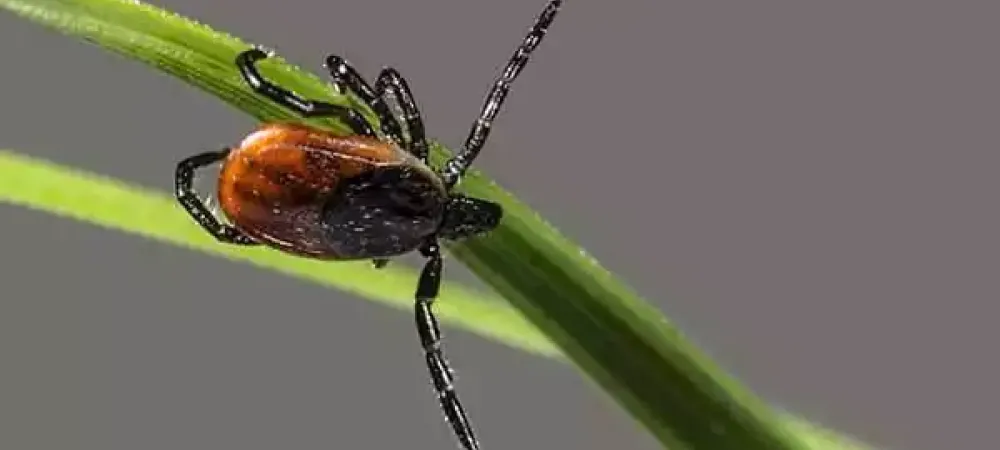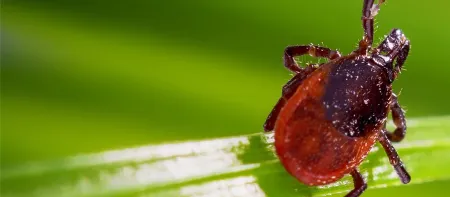Guide to Avoiding Ticks in Illinois

Identifying Ticks in Illinois
What are Ticks?
Ticks are a parasite in the arachnid class of insects. In their larval and adult stages, ticks attach to an animal or human, biting and feeding on their blood for several days. When they bite, they can also transmit any diseases they carry into the host’s bloodstream. Ticks cannot fly and are slow crawlers. To attach to a host, they wait on grass or shrubs and climb on when the host brushes by. They can also move from host to host, especially animals.
Common Ticks in Illinois
According to the Illinois Department of Public Health, there are four types of ticks in Illinois that people should be concerned about:
American dog tick – Also known as the wood tick, this is the most common tick in Illinois. These ticks are red in color and usually 3/16 of an inch long, with well-fed females growing as large as 1/2 an inch in length. Females also have a small silver spot behind their heads. Most active in April through June, the American dog tick has been known to transmit Rocky Mountain spotted fever and ehrlichiosis.
Lone Star tick – The Lone Star tick is a small (1/8 an inch long), brown tick found mostly in southern Illinois. Aside from a small white dot on the back of females, this tick is similar in appearance to the black-legged tick. In its larvae state, the tick is barely noticeable, looking like a pinhead or small freckle on your skin. Active in April through July, the Lone Star tick can transmit Rocky Mountain spotted fever as well as other bacterial infections.
Blacklegged Tick – Known as the deer tick, this is an active tick reddish-brown in color and growing to 1/8 an inch in length. Deer ticks are active from spring through the fall, depending on the life stage it is in. The deer tick is common in wooded areas in Michigan, Minnesota, and Wisconsin and has been making its way into northern Illinois in recent years. It is known to transmit Lyme disease and ehrlichiosis to humans.
Brown Dog Tick – Also known as the kennel tick, this species only infects dogs. It is not usually found outdoors in Illinois; rather, it is transmitted indoors from dog to dog, like at a kennel or breeder.
Why are Ticks Dangerous?
When ticks bite, they can also infect their host with whatever virus or bacteria they are carrying, causing a serious infection in the host. Not every tick carries these diseases, so not every tick bite will get you sick. However, these illnesses are significant and will require immediate medical attention at the first sign of symptoms.
Here are some of the more serious common tick-borne diseases in Illinois:
Lyme disease – Lyme disease is a bacterial infection carried by ticks found in the northeastern and north-central United States, including Illinois. The most noticeable symptom of Lyme disease is a a red bulls-eye rash appearing at the bite mark within days of being infected. Other symptoms include fever, chills, fatigue, headache, and joint pain. Many of these symptoms can be misinterpreted as the flu; it is crucial to get proper medical attention before the symptoms get more severe.
Rocky Mountain spotted fever – The Rocky Mountain spotted fever is a bacterial infection transmitted by the American dog tick and Lone Star tick into humans. Symptoms include a sudden moderate or high fever, headache, fatigue, and a rash that starts on the limbs and may spread to your palms or the soles of your feet. Symptoms appear within two weeks of infection.
Ehrlichiosis – Ehrlichiosis is a bacterial illness carried by ticks found in the Great Lakes region, including northern Illinois. Symptoms of this disease include muscle aches, fever, and headaches. Symptoms are usually mild and can appear 1-3 weeks after the tick bites.
Powassan – Powassan is a tick-borne virus found in the Northeast and Great Lakes areas. This disease infects a patient’s nervous system, causing inflammation of the brain and meningitis. Unlike the bacterial infections listed above, Powassan has no known treatment. Symptoms include headaches, vomiting, confusion, difficulty speaking or walking, and seizures.
Many of these illnesses share similar symptoms with each other and with less severe ailments like the flu. If you discover a tick biting you, find a rash, or are concerned you may have come in contact with a tick, consult a medical provider immediately. Blood tests can reveal if you are infected, and it is best to start treatments as soon as possible to minimize the effects.
Where do ticks live?
Since there is no vaccination for most of these diseases, the best way to protect yourself is to avoid tick-infested areas. Ticks like to hide on tall vegetation, where they can jump onto animals or clothing that brushes up close by. You’ll find a greater concentration in heavily wooded areas, parks, and nature trails. In your backyard, ticks can be found in high grasses and landscape shrubs, as well as piles of leaves.
How to Avoid Ticks
Safety Precautions
When you walk or go on a hike in a forest preserve, stick to the trails and avoid tall vegetation. Avid hikers are known to wear tucked-in long sleeve shirts with their pants tucked into their socks to avoid any potential bare skin.
Check for Ticks
If you know you or your family has been in a place where ticks live, you’ll want to perform a thorough tick inspection of your clothing and skin. Ticks like to hide in hard-to-reach areas, including but not limited to the scalp, neck, ears, armpits, and groin. Be sure to also check your children and pets.

Remove Ticks Immediately
If you find a tick crawling around, remove it immediately and destroy it. If you find a tick that’s attached itself by biting you, you’ll need to use tweezers to remove the tick by pulling upwards. Make sure you get the whole tick, as the head can break off and be left within your skin. To remove ticks from clothing, first wash them in hot water and then place the clothing in a dryer set to dry on high heat for a minimum of 10-15 minutes.
Keeping Ticks Away from Your Yard
There are some specific steps you can take to make your property less attractive to ticks. This includes clearing tall grasses and brush, removing leaf litter, mowing your lawn regularly, and creating a barrier between your lawn and any wooded areas with wood chips or gravel.
Yard Treatment Options
Pest control treatments are available to control existing tick infestation. There are also perimeter yard treatments available that help deter ticks from entering your property.
Contact your local professional pest control company for more information.
Resources:
Illinois Department of Public Health – Information on Common Ticks: https://www.idph.state.il.us/envhealth/pccommonticks.htm
Illinois Department of Public Health – Map of Deer Tick: https://www.idph.state.il.us/envhealth/pdf/Deer_Tick_Range.pdf
Centers for Disease Control – Ticks: https://www.cdc.gov/ticks/index.html

